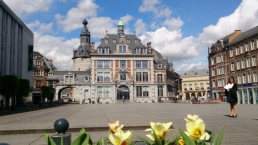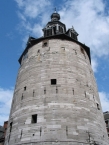Cycle Route La Namuroise
No. of cycle route RV2
Actions
![]()
Please wait - map data are loading
Added on 02 Apr 2012,
last edited by biroto-Redaktion on 25 Nov 2020
Actions
Cycle route metrics
Total distance in km
166
Information about rights to the gps-track data | |
|---|---|
Rights owner | OpenStreetMap and Contributors + biroto-Redaktion (biroto.eu) |
Rights characteristic / license | Contains information from OpenStreetMap, which is made available here under the Open Database License(ODbL) |
Link to the description of the license | |
GPX file taken from | |
GPX file uploaded | by biroto-Redaktion on 25 Nov 2020
|
Track points in total
2.554
Track points per km (avg)
15
Start/endpoint
Start location
Hoegaarden, Flanders, BE (54 m NHN)
End location
Bouillon, Wallonia, BE (281 m NHN)
Beds4Cyclists, worth visiting and infrastructure
Name and address
Latitude / Longitude
Phone
Fax
Mobile
Type of accommodation
Rating for cyclists
Route km
Dist. to route
Elevation
0 km
4,5 km
43 m
Information about copyright | |
|---|---|
Rights owner | |
Rights characteristic / license | by-sa: CREATIVE COMMONS Attribution-ShareAlike |
Link to the description of the license | |
Image taken over from | https://commons.wikimedia.org/wiki/File:42839_OLV_ten_Poelkerk_Tienen.jpg |
Image has been uploaded | by biroto-Redaktion on 28 Mar 2019
|
Tienen oder auch Thienen (französisch Tirlemont) ist eine Stadt und Gemeinde in der Provinz Flämisch-Brabant in Belgien. Die Gemeinde hat 34.675 Einwohner (Stand 1. Januar 2018). I
Geschichte
Die Region wurde in vorchristlicher Zeit von Kelten (Galliern) bewohnt. Regelmäßig werden in der Gemeinde archäologische Grabungen durchgeführt, die schon viele oft überraschende Funde brachten (zu sehen im Museum „Het Toreke“; siehe auch die Website der Stadt). Wahrscheinlich hat das uradelige Geschlecht der Freiherren von Thienen-Adlerflycht die Stadt um das Jahr 800 nach Christus begründet und beherrscht und sich so nach der Stadt benannt. Im 13. und 14. Jahrhundert war Tienen wichtig wegen der Lakenweberei. Nach 1500 ging ihre Wirtschaft jedoch bergab. Tienen wurde mehrmals von Kriegshandlungen heimgesucht, unter anderem einige Male im 16. Jahrhundert, 1635 (fast völlige Zerstörung) und 1914.
Sehenswürdigkeiten
Kirchen
- ⊙Onze Lieve Vrouwe ten Poel (St. Maria am Teich): 1297 erbaut; 1357 in gotischem Stil neu gebaut; der Turm ist 70 Meter hoch und von weitem sichtbar; die Turmspitze und das Kirchenmobiliar sind in Barockstil gehalten.
- ⊙ St. Germanus-Kirche (1323) am Viehmarkt, dem ältesten Marktplatz der Stadt. Der Baustil ist zum Teil romanisch, zum Teil gotisch. Ein Glockenspiel aus dem Jahr 1723 und eine schöne Orgel, teilweise aus dem 17. Jahrhundert, gehören zur Ausstattung der Kirche.
- ⊙ Ruine der Paterskerk
(Brüderkirche) des Beginenhofes in einer Parkanlage
Museen
- ⊙ Das Zuckermuseum
- ⊙ Das Historische Museum im ehemaligen Gefängnis „Het Toreke“ (Das Türmchen)
- ⊙ Das Museum des Puppentheaters
Sonstiges
- Eine Stadtwanderung durch die historische Altstadt lohnt sich: es gibt noch mehrere schöne alte Häuser, unter anderem beim ehemaligen Beginenhof
Information about copyright | |
|---|---|
Rights characteristic / license | by-sa: CREATIVE COMMONS Attribution-ShareAlike |
Link to the description of the license | |
Input taken over from: |
Seite „Tienen“. In: Wikipedia, Die freie Enzyklopädie. Bearbeitungsstand: 17. Dezember 2017, 17:30 UTC. URL: https://de.wikipedia.org/w/index.php?title=Tienen&oldid=172055996 (Abgerufen: 28. März 2019, 09:51 UTC) |
taken over / edited on | 28 Mar 2019
|
taken over / edited by |
|
38 km
0,6 km
89 m
Hours of opening
Open every day from 9.30am to 6pm
Languages spoken:
française
38 km
0,6 km
87 m
39 km
0,4 km
87 m
Information about copyright | |
|---|---|
Rights owner | |
Rights characteristic / license | by-sa: CREATIVE COMMONS Attribution-ShareAlike |
Link to the description of the license | |
Image taken over from | |
Image has been uploaded | by biroto-Redaktion on 04 Apr 2015
|
Information about copyright | |
|---|---|
Rights owner | |
Rights characteristic / license | by-sa: CREATIVE COMMONS Attribution-ShareAlike |
Link to the description of the license | |
Image taken over from | |
Image has been uploaded | by biroto-Redaktion on 04 Apr 2015
|
Information about copyright | |
|---|---|
Rights owner | |
Rights characteristic / license | by-sa: CREATIVE COMMONS Attribution-ShareAlike |
Link to the description of the license | |
Image taken over from | |
Image has been uploaded | by biroto-Redaktion on 04 Apr 2015
|
Information about copyright | |
|---|---|
Rights owner | |
Rights characteristic / license | by-sa: CREATIVE COMMONS Attribution-ShareAlike |
Link to the description of the license | |
Image taken over from | |
Image has been uploaded | by biroto-Redaktion on 04 Apr 2015
|
Namur (French pronunciation: [namyʁ], Dutch: Namen, Nameur in Walloon) is a city and municipality in Wallonia, in southern Belgium. It is both the capital of the province of Namur and (since 1986) of Wallonia. It hosts the Walloon Parliament.
Namur stands at the confluence of the Sambre and Meuse
rivers and straddles three different regions - Hesbaye to the north, Condroz to the south-east and Entre-Sambre-et-Meuse to the south-west. The language spoken is French.
Understand
The town began as an important trading settlement in Celtic times, straddling east-west and north-south trade routes across the Ardennes. The Romans established a presence after Julius Caesar defeated the local Aduatuci tribe.
Namur came to prominence during the early Middle Ages when the Merovingians built a castle or citadel on the rocky spur overlooking the town at the confluence of the two rivers. In the 10th century, it became a county in its own right. The town developed somewhat unevenly, as the counts of Namur could only build on the north bank of the Meuse - the south bank was owned by the bishops of Liège and developed more slowly into the town of Jambes (now effectively a suburb of Namur). In 1262, Namur fell into the hands of the Count of Flanders, and was purchased by Duke Philip the Good of Burgundy in 1421.
After Namur became part of the Spanish Netherlands in the 1640s, its citadel was considerably strengthened. Louis XIV of France invaded in 1692, capturing the town and annexing it to France. His renowned military engineer Vauban rebuilt the citadel. French control was short-lived, as William III of Orange-Nassau captured Namur only three years later in 1695 during the War of the Grand Alliance. Under the Barrier Treaty of 1709, the Dutch gained the right to garrison Namur, although the subsequent Treaty of Utrecht of 1713 gave control of the formerly Spanish Netherlands to the Austrian House of Habsburg. Thus, although the Austrians ruled the town, the citadel was controlled by the Dutch. It was rebuilt again under their tenure.
France invaded the region again in 1794, during the French Revolutionary Wars, and again annexed Namur, imposing a repressive regime. After the defeat of Napoleon in 1815, the Congress of Vienna incorporated what is now Belgium into the United Kingdom of the Netherlands. Belgium broke away from the Netherlands in 1830 following the Belgian Revolution, and Namur continued to be a major garrison town under the new government. The citadel was rebuilt yet again in 1887.
Namur was a major target of the German invasion of Belgium in 1914, which sought to use the Meuse valley as a route into France. On August 21st, 1914, the Germans bombarded the town of Namur, without any previous notice given. Several persons were killed. Despite being billed as virtually impregnable, the citadel fell after only three days' fighting and the town was occupied by the Germans for the rest of the war. Namur fared little better in World War II; it was in the front lines of both the Battle of the Ardennes in 1940 and the Battle of the Bulge in 1944. The town suffered heavy damage in both wars.
Namur continued to host the Belgian Army's paratroopers until their departure in 1977.
See
- ⊙ The town's most prominent sight is the citadel, now demilitarised and open to the public.
- ⊙ 18th century Cathédrale Saint-Aubain
- ⊙ The Saint Loup church, located in the historical heart of the city, is one of the most beautiful pieces of baroque art inherited from the former southern Netherlands, mid-July to mid-September: We: 2:00 pm - 6:00 pm Sa: 11:00 am - 6:00 pm (guided tour on 3 PM) Su: 2:00 pm - 6:00 pm, September to June) Sa: 11:00am - 4:00pm (guided tour on 3:00 PM).
- ⊙Belfry
classified by UNESCO as part of the Belfries of Belgium and France which are listed as a World Heritage Site.
- ⊙Musée provincial des arts anciens, Rue de Fer, 24, ☎ +32 81 220065.daily, from 10:00 to 18:00. Closed on Mondays. Adults 3 €, students and senior citizens 1,50€, Children under 12 free. Medieval and Renaissance collections of the Namur Archaeological Society and the extraordinary medieval treasury of the Saint-Nicolas d’Oignies priory.
- ⊙Musée diocésain et trésor de la cathédrale Saint-Aubain (Diocesan Museum houses the prestigious treasury of Saint- Aubain), Place du Chapitre, 1 (The museum can be accessed via the cathedral), ☎ +32 81 444285, ☎ +32 476 972324. Reserve your visit by telephone at M. Jacques Jeanmart, Rue de l'Eglise, 5150 Franière phone numbers see above. Adults2,50 €, students and senior citizens 2 €, groups1,50 €, children 1 €. Gold and silver pieces (XI to XVIII century), sculptures and paintings from parishes and ancient abbeys of the diocese of Namur. Mediaeval glasses, textiles and manuscripts.
An odd Namurois custom is the annual Combat de l'Échasse d'Or (Fight for the Golden Stilt), held on the third Sunday in September. Two teams, the Mélans and the Avresses, dress in medieval clothes while standing on stilts and do battle in one of the town's principal squares.
Information about copyright | |
|---|---|
Rights characteristic / license | by-sa: CREATIVE COMMONS Attribution-ShareAlike |
Link to the description of the license | |
Input taken over from: |
|
taken over / edited on | 04 Apr 2015 - 09 Apr 2022
|
taken over / edited by |
|
40 km
0,5 km
82 m
![]()





